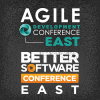Agile Development Conference & Better Software Conference East 2012

PRESENTATIONS
|
A Big Helping of DevOps with Career Advice on the Side
For decades-with the exception of agile-dev followers-the IT community has continued to build and protect its departmental silos. Project management, business analysis, development, testing, DB administration, and operations are just a few of the specializations that are carved out and institutionalized. Agile practices seek to eliminate the walls and empower people to deliver the highest value to the business. |
|
|
Adaptive Leadership: Accelerating Enterprise Agility
Agile practices have proven to help software teams develop better software products while shortening delivery cycles to weeks and even days. To respond to the new challenges of cloud computing, mobility, big data, social media, and more, organizations need to extend these agile practices and principles beyond software engineering departments and into the broader organization. |
|
|
Agile at Scale with Scrum: The Good, the Bad, and the Ugly
Come hear the story of how a business unit at one of the world's largest networking companies transitioned to Scrum in eighteen months. The good-more than forty teams in one part of the company moved quickly and are going gangbusters. The bad-an adjacent part failed in its transition. The ugly-if you're in a large company with globally distributed teams, it's not hard to torpedo Scrum adoption. |

Steven Spearman, AgileEvolution |
|
Agile Development Conference & Better Software Conference East 2012: Seven Deadly Habits of Dysfunctional Software Managers
As if releasing a quality software project on time were not difficult enough, poor management dealing with planning, people, and process issues can be deadly to a project. Presenting a series of anti-pattern case studies, Ken Whitaker describes the most common deadly habits-and ways to avoid them. |

Ken Whitaker, Leading Software Maniacs |
|
Back to the Basics: Principles for Constructing Quality Software
Using an analogy to the building codes followed by architects and contractors in the construction of buildings, Rick Spiewak explores the fundamental principles for developing and delivering high quality, mission-critical systems. Just as buildings are constructed using different materials and techniques, we use a variety of languages, methodologies, and tools to develop software. |
|
|
Better Software Conference East 2012: Data Collection and Analysis for Better Requirements
According to the Standish group, 64 percent of features in systems are rarely-or never-used. How does this happen? Today, the work of eliciting the customers' true needs, which remains elusive, can be enhanced using data-driven requirements techniques. Brandon Carlson introduces data collection approaches and analysis techniques you can employ on your projects right away. Find out how to instrument existing applications and develop new requirements based on operational profiles of the current system. |

Brandon Carlson, Lean TECHniques, Inc. |
|
Better Software Conference East 2012: Lean Development Practices for Enterprise Agile
Enterprise agile initiatives require strategic, portfolio, product, and team perspectives at all levels. Alan Shalloway has found that lean software development principles help integrate all of these perspectives into a cohesive, actionable whole. With a combination of lean science, lean management, lean team, and lean learning methods, Alan shows how your organization can prepare for enterprise agility. Lean science focuses on the “laws” present in all software development projects. |
|
|
Better Test Designs to Drive Test Automation Excellence
Test execution automation is often seen as a technical challenge-a matter of applying the right technology, tools, and smart programming talent. However, such efforts and projects often fail to meet expectations with results that are difficult to manage and maintain-especially for large and complex systems. Hans Buwalda describes how the choices you make for designing tests can make-or break-a test automation project. |
Hans Buwalda, LogiGear Corporation |
|
Beyond Processes and Tools: What about Ethics?
Too often we focus only on the latest headline-grabbing processes and products. While recognizing that we must respond to ever-changing business needs, deep down we know we must live by a few absolutes as we approach our daily work. At the core is a standard of ethical conduct that we always uphold. With an ethical underpinning, we will earn the trust and respect of our peers and those we serve. |
|
|
Cloud Computing: Powering the Future of Development and Testing
Developers and testers are under constant pressure to operate more efficiently, cut costs, and deliver on time. Without access to scalable, flexible, and cost effective computing resources, these challenges are magnified. Brett Goodwin explains how to create scalable dev/test environments in the cloud, and shares best practices for reducing cycle time and decreasing project costs. |

Brian White, Skytap, Inc. |


